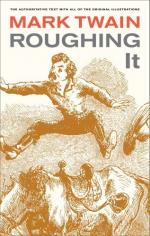Esmeralda was in many respects another Humboldt, but in a little more forward state. The claims we had been paying assessments on were entirely worthless, and we threw them away. The principal one cropped out of the top of a knoll that was fourteen feet high, and the inspired Board of Directors were running a tunnel under that knoll to strike the ledge. The tunnel would have to be seventy feet long, and would then strike the ledge at the same dept that a shaft twelve feet deep would have reached! The Board were living on the “assessments.” [N.B.—This hint comes too late for the enlightenment of New York silver miners; they have already learned all about this neat trick by experience.] The Board had no desire to strike the ledge, knowing that it was as barren of silver as a curbstone. This reminiscence calls to mind Jim Townsend’s tunnel. He had paid assessments on a mine called the “Daley” till he was well-nigh penniless. Finally an assessment was levied to run a tunnel two hundred and fifty feet on the Daley, and Townsend went up on the hill to look into matters.
He found the Daley cropping out of the apex of an exceedingly sharp-pointed peak, and a couple of men up there “facing” the proposed tunnel. Townsend made a calculation. Then he said to the men:
“So you have taken a contract to run a tunnel into this hill two hundred and fifty feet to strike this ledge?”
“Yes, sir.”
“Well, do you know that you have got one of the most expensive and arduous undertakings before you that was ever conceived by man?”
“Why no—how is that?”
“Because this hill is only twenty-five feet through from side to side; and so you have got to build two hundred and twenty-five feet of your tunnel on trestle-work!”
The ways of silver mining Boards are exceedingly dark and sinuous.
We took up various claims, and commenced shafts and tunnels on them, but never finished any of them. We had to do a certain amount of work on each to “hold” it, else other parties could seize our property after the expiration of ten days. We were always hunting up new claims and doing a little work on them and then waiting for a buyer—who never came. We never found any ore that would yield more than fifty dollars a ton; and as the mills charged fifty dollars a ton for working ore and extracting the silver, our pocket-money melted steadily away and none returned to take its place. We lived in a little cabin and cooked for ourselves; and altogether it was a hard life, though a hopeful one—for we never ceased to expect fortune and a customer to burst upon us some day.
At last, when flour reached a dollar a pound, and money could not be borrowed on the best security at less than eight per cent a month (I being without the security, too), I abandoned mining and went to milling. That is to say, I went to work as a common laborer in a quartz mill, at ten dollars a week and board.




